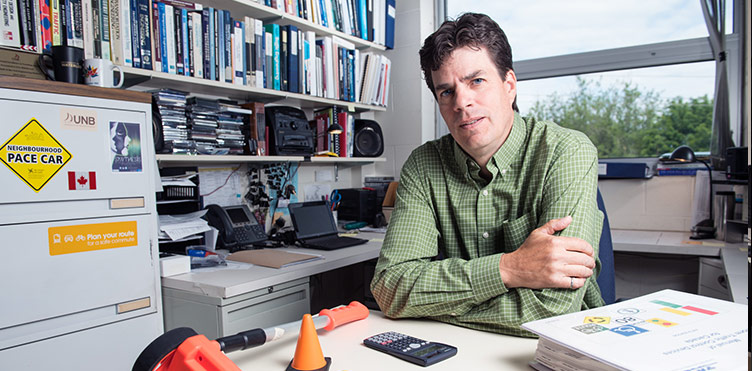Collision investigation team

Operating in Canada since 1970, we are a national network of university-based collision and defect investigation teams, sponsored by the Road Safety Directorate of Transport Canada. The geographically dispersed teams provide a mechanism for the Directorate to monitor vehicle safety issues across the country.
Our mandate is to study all aspects of motor vehicle collisions (human, vehicular and environmental) and safety-related defects including public complaints of alleged defects. This program supports the Directorate's public complaint system to influence motor vehicle recalls.
Teams function as regional sources of expertise and have provided valuable input into provincial, regional and local safety issues. Each team also serves to disseminate information to the general public and plays a role in training road safety professionals in Canada.
Team members
Ryan Esligar, MScE, PEng
Project Investigator
Cell: 506 474 3408
Phone: 506 451 4400 ext 1317
Ryan.Esligar@englobecorp.com
Eric D. Hildebrand, PhD, PEng
Team Coordinator
Phone: 506 453 5113
edh@unb.ca
National collision investigation program
The investigation team system in Canada began as a mechanism to examine passenger car collisions. This mandate was later expanded to address safety related concerns for other vehicle types. In recent years, the focus of the collision investigation program has been the directed studies initiative. Directed studies are intended to examine specific areas of interest to the Directorate.
These areas of interest may be identified based on:
- vehicle type
- safety devices involved
- collision configuration
- occupant age, etc.
Directed studies have included:
- collisions involving airbags
- moderately severe side impacts
- light trucks and vans,
- heavy trucks.
Part of the directed studies program requires the university teams to conduct special investigations. Special investigations normally involve collisions that have a large numbers of fatalities, are of a spectacular nature, or are of special interest to the Directorate. Special investigations have included collisions involving school buses, child restraint systems and propane fueled vehicles.
Investigative approach
To obtain information pertaining to motor vehicle collisions, the UNB team relies on the continuing cooperation of numerous partners including personnel from provincial government departments, police forces, medical institutions, towing companies, vehicle holding compounds and auto repair shops.
Team investigators complete first-hand examinations of each collision scene. These examinations sometimes involve being called by police to attend 'live scenes'. Road geometry (alignment, grade, elevations, etc) and scene evidence (vehicle resting positions, tire marks, gouges, fluid trails, etc) are recorded electronically using 'total-station' geographic survey equipment. The digital files obtained from these surveys were used to produce scale diagrams for each of the collision scenes. Environmental factors such as the weather condition, time of day and road condition at the time of collision are also recorded.
Vehicle damage information and crush measurements are recorded for all vehicles involved in the sampled collisions. Vehicle exterior damage information is used to help determine collision dynamics and assess collision severity. Vehicle interior damage is used to assess occupant risk of injury and possible injury mechanisms.
Detailed injury information is collected for vehicle occupants involved in each collision. Occupant injury information and any contact evidence in the vehicle are used to help identify occupant injury mechanisms. Occupant injuries are coded and ranked according to practices specified in the National Accident Sampling System (NASS) Injury Coding manual. A maximum abbreviated injury scale (MAIS) value is assigned to each occupant based on the most severe injury they sustained during a collision.
A detailed set of photographs is recorded and compiled for each vehicle and collision scene. The vehicle exterior photographs include close-ups of areas with collision-related damage and contact evidence. Photographs of vehicle interiors are used to document interior damage, occupant contact points, restraint equipment and seating configuration / geometry.
Studies
Advanced airbag study
Examines collisions during which a front airbag has deployed in a vehicle that is equipped with an Advanced Airbag System. An Advanced Airbag System is designed to detect whether or not a passenger is present in the front passenger seat. If a passenger is detected the system also determines the approximate size of this passenger and uses this information to decide whether or not the front airbag will be deployed during a collision. These systems are typically found in vehicles with a model year of 2006 or newer.
Moderately severe side impact study
Examines collisions involving a side impact or rollover in vehicles that are not more than ten years old. The side impact can occur on either the left or right side of the vehicle but it must be adjacent to an occupant. Vehicle rollovers accompanied with the deployment of a side or side-curtain airbag are also acceptable. The purpose of this study is to evaluate the vehicle’s performance during side impacts and to determine the injuries that occur to any occupant near the impact zone.
Rear occupant protection study
Focuses on the safety of restrained rear occupants in collisions that are severe enough to deploy the front airbags. The vehicle must have been in a crash that resulted in a front airbag deployment and at least one rear occupant must have been fully restrained with a 3-point seatbelt (this includes children in booster seats).
Special studies
There are other types of collisions that do not meet the requirements of the three studies identified above, but that are still of interest to Transport Canada. These types of collisions are categorized as ‘special studies’ and include collisions involving school buses, highway coaches, child restraint systems, seatbelts, event data recorders (EDRs), etc.
The findings of these studies are used to support regulatory action under the Motor Vehicle Safety Act.
Road safety audit guidelines
A set of guidelines for the construction of road safety audits within a Canadian context is provided. The document contains a description of existing practices, audit process, economies, legal issues, case studies and a comprehensive series of checklists which reflect Canadian practices.
The project was undertaken as a result of funding provided by the Maritime Road Development Corporation and the National Research Council's Industrial Research Assistance Program.
